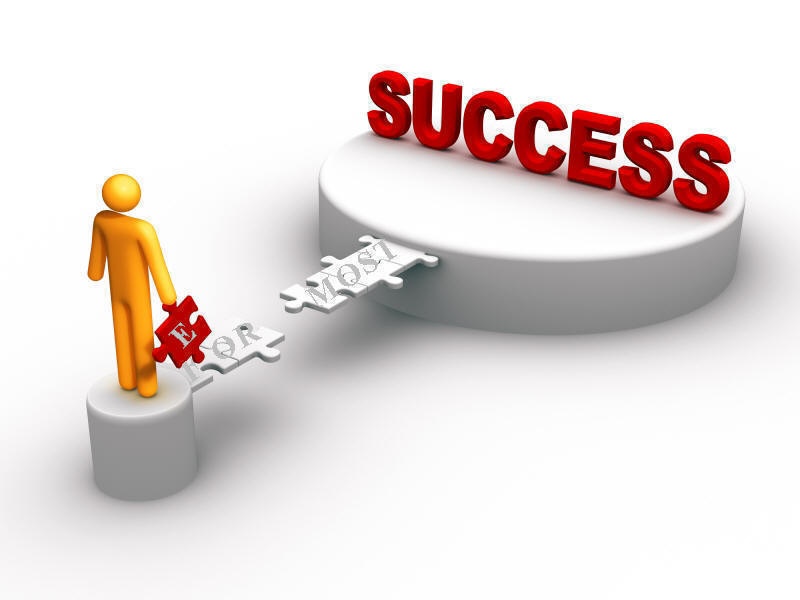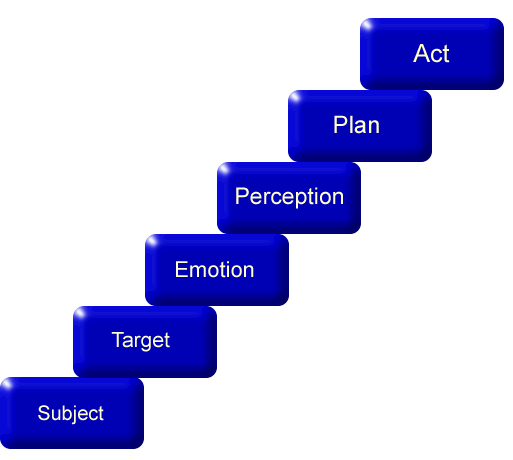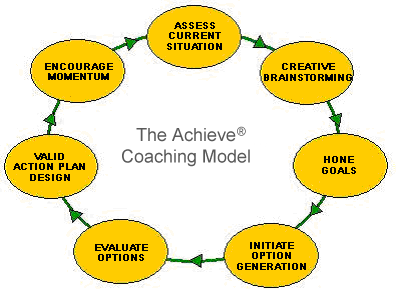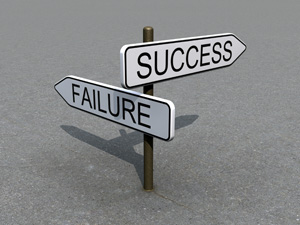focus on the positive of any situation. They get their “high” from doing this.
This is a behavior that anyone can emulate; it's vital to your coachee's success to think and recall positive moments their life so they can continually build on them.
Chart Your Course
Here's where a lot of the coaching takes place, you'll be working with your coachees on the topic that they've chosen.
Obviously, you'll be asking a lot of questions trying to help them move forward towards his goals.
Creating Opportunities
What does your coachee need to move forward?
You're helping them figure out what specific opportunities exist or they can create to accomplish their goals.
Expectations and Commitments
What does your coachee expect to achieve?
Personal change requires action and a commitment to action.
You cannot expect someone to change, unless they're committed to change, which means taking action.
Synergy
How is the energy between what your coachees have chosen to do and how they feel about doing them?
If it's not congruent, they're going to have a hard time changing.
A big reason why people end up not doing what they've committed to do, is because they don't really feel all that good about doing something else...perhaps they feel a lot better doing what they've always done.
233

This creates blocked energy...and energy influences many levels.
...more than we can consciously perceive.
Summary
What did they get out of it?
This step is a recap of what's been worked on during the session.
This could be the most important step of all. If coachees don't anchor their thoughts and ideas, they'll likely forget them as soon as they step out the door.
So make sure you're asking your coachee what they learned. Ask them to write it down, not just to say it; they'll get a lot more out of the session.
(©2001-2009
What-IS-Coaching.
All
Rights
Reserved.
Article written by Jean Paul Cortes.)
234
2.18 STEPPPA COACHING MODEL
From Angus McLeod, author of Performance Coaching: The Handbook for Managers, HR Professionals and Coaches, ISBN
978-1904424055
STEPPA actually stands for:
Subject
Target Identification
Emotion
Perception and Choice
Plan
Pace
Adapt or Act
We'll go over the individual steps in a minute, but first so you can better understand what this model is all about we need to go over something.
The underlying principle behind this model is working with your emotions. You see, according to this model behaviors are driven by emotion, which means that action is motivated by the emotional commitment that people have to achieve a given goal.
Keeping this in mind, we can go over each of the building blocks of this model:
Subject
The coach needs to check that the subject is one that is permitted within the terms of any contract.
What do you want to talk about? That's the subject of a coaching process; as you can probably realize, this is tied with having a clear understanding of your goals. Remember that you're the best person to know what it is that you want to achieve, a coach 235
is there to help you gain clarity around that, so that you can increase the effectiveness of getting to your goal.
Target Identification
Very often, the coachee also brings a target (goal) with them to the session
It's pretty hard to hit a target that you can't see isn't it? What tends to happen very often is that we don't know exactly what we want and not knowing, we don't know where to start. Not only must you select a target, you also have to keep it in sight in order to hit it; if I asked you to stand in the middle of a room and select a target and then close your eyes, spin a few times and then try to hit your selected target, how many times do you think you'd be successful at it? Go ahead try this exercise, then let me know what you found...
Emotion
The coachee will have a range of emotions associated to the subject which must be considered
As mentioned above, emotions actually drive our behaviors that's why it's important for you to have a deep knowledge of how your emotions could be affecting your motivation towards achieving a goal. Is the goal worth it? If you can't answer that question, then spend some time searching for those that do or in learning ways to overcome your aversions (if it's really worth it).
Perception and Choice
Coaches aim to widen the coachee’s conscious perception of their issues and targets.
236
We still haven't found out a way of getting into people's minds and fully understand what their perception of reality is, this is unique to every single one of us. What we can do, is try to understand what our particular perception is to try and broaden our horizon. By consciously engaging in asking ourselves what something “means” to us, we can choose the route we want to take towards achieving a goal. Insight comes from this process of developing more and more ways of understanding ourselves.
Plan
The plan (P2) leads to the Target. It will be a process, not a series of choices.
Every plan is actually a process, life is full of twist and turns so having something etched in stone is probably not in your best interest. You constantly have to revise, look at and course correct. While the shortest way to two points is a straight line, we all know that life is complicated and we should remain flexible enough to change course if needed.
Pace
Pay attention next time you're driving on the highway, if you notice you'll see distance markers every so often, these are meant to give an idea of how far you've gone. When you establish goals, you need to know and have a system to measure your progress. By when will you achieve this goal?
Adapt or Act
It is important to adequately review the Plan before seeking commitment.
237

Every coaching model is intended to move you into action, that is your commitment to yourself. It takes time, nobody is saying that you're going to change today or tomorrow but sooner or later you'll realize that by taking that first step and then another, and another, and another (you get the picture), you'll eventually reach your destination.
238
2.19 WHAT COACHING MODEL
Effectively discover what is behind your behaviors.
How? By finding out what may be driving HOW you do things.
Perhaps you've heard that one of the surest ways of gaining insight into one's personality, behaviors or limiting beliefs is by asking questions of oneself. I'm sure you've been asked the who, why, when, where and how?
I'm also sure that if you're like most people, you're likely to draw blanks more times than not. These days it's hard to keep track of even the simplest things, let alone trying to come up with answers to sometimes complex situations.
It makes much more sense to focus on a specific question, I'll tell you why in a second.
Let me ask you a question first, when you're asked to answer why, how does it make you feel?
If I'm right, do you want to know why you feel that way? Hang on for a second...
When someone asks us why we did something it normally brings up a funny reaction in us humans. You see, we want to be consistent with what we say or think and why tends to make us feel like we should justify ourselves, like we're being judged, and nobody likes that.
What ends up happening is that we tend to cling to our views, blocking our ability to see other perspectives and perhaps limiting our growth.
Something similar happens when we're asked how? On simple problems this question may be easily answered, but rarely is a 239
problem simple and answering this question will likely involve having to come up with different processes, time lines, resources all of which is time consuming and requires a lot of effort.
What Is The Better Question?
What is your life vision?
If you can get this, just the way you want it, what is the best thing about it?
Okay, so what is the first step to take to have that?
What will you do by next week?
What is the main obstacle that's preventing you from getting this?
What would it take to get past this block?
If you could freely overcome these obstacles, what would that mean for you?
What is your dream-line?
What is the number one thing you got out of this session?
Do you catch my drift? When you ask what, you're focusing your mind on a single item, one that's not looking for a reason or that's too difficult to answer. It very often provides us with a simple way to find a solution regardless of what you're answering.
Even if you don't want to entirely base your coaching strategy solely on this question, you certainly want to use it as a valid approach to finding and coaching many issues. The next time you're looking for a solution, make sure to ask what?
(©2001-2009
What-IS-Coaching.
All
Rights
Reserved.
Article written by Jean Paul Cortes.)
240
2.20 ACHIEVE COACHING
A = Access current situation
C = Creative brainstorming of alternative to current situation H = Hone goals
I = Initiate options
E = Evaluate options
V = Valid action programme design
E = Encourage momentum
The Achieve Coaching Model® - banishing the black box Our thinking for the Achieve Coaching Model® has been developed through reviewing the literature and best practice in Germany, the UK and the US. It aims to make the coaching process completely transparent and credible for the coachee –
rather than a magical process in a black box.
The model reflects our findings that experienced coaches who achieve tangible and sustainable results use seven elements in their coaching, whether consciously or unconsciously. These are described below.
Assessment of current situation – to get where you where you want to go, it helps to know what’s not working where you are.
This time and space is the starting point of any coaching assignment and highlights for the coachee potential areas for the coaching, examining the factors that have led to the current situation, including their own behaviour.
A smaller, but still vital benefit is that this session also helps the coach understand the context in which the coachee works.
Creative brainstorming of alternatives – this phase of the coaching is about the exploration of possibilities – what might change the current situation. Many coachees we see are “stuck” in a particular situation, with seemingly few alternative ways of 241
doing things. Here, we work with the coachee to clarify what they want to achieve, and increase the options that they have to tackle their goal.
Hone goals – generating alternatives to the situation gives coachees a sense of what they want to achieve. The next step is to get SMART – or define exactly what it is they want, so that it’s measurable and they know when they’ve achieved it.
Initiation and evaluation of options – When the coachee has a clear goal and a range of options to get there – that’s when we evaluate what’s the best option to take. This isn’t a case of sticking with the familiar, this element of the process is to carefully sift ALL the options to choose, and then take, a first step.
This incorporates thinking from business planning processes, but we’ve kept it simple – a straightforward evaluation matrix with the criteria defined by the coachee.
Valid action plan – with the deliberation over the ‘what’ nearly completed, we now move onto the ‘how’. A concrete and practical action plan breaks down what are often big changes into smaller, doable steps.
Encourage momentum – all the way through the process, the coach is there to keep the coachee on track, enthused and positive. This takes place between each session as well as at the end of the sessions.
This last part illustrates an important characteristic of our model – although it’s displayed in a linear diagram, the process is not linear – it is iterative and completely dependent on the coachee, and so parts of it are used at different times, and may be repeated. For example, setting goals is done at the end of every session not just the end of the process.
242
Coaches may generally all start in the same place and finish in the same place, but they’ll use parts of the process depending on issues brought up and discussed in the coaching.
© The Coaching and Communication Centre 2002-2008
The Achieve Coaching Model® - A Systematic Approach to Greater
Effectiveness
in
Executive
Coaching
An article by Dr. Sabine Dembkowski and Fiona Eldridge Introduction
Everyone in the business coaching profession agrees that executive coaching works. However, according to Coaching and Buying Coaching Services (London: Chartered Institute of Personnel and Development, 2004), an even greater impact, more sustainable results and increased effectiveness can be achieved when a systematic approach to executive coaching is applied.
Novice coaches wonder if effective, experienced coaches possess mysterious methods for producing magical results. In fact, the genuine trust that renders coaching effective is created when both coach and coachee have a clear understanding of the coaching process and methodology. We have always believed in the value of such transparency, and have made it a cornerstone of our practice. To validate our belief, we conducted research and monitored our own coaching results.
In order to determine and define what actually happens in sessions facilitated by an effective coach, we observed and analyzed transcripts and video tapes from executive coaching colleagues in the US, England and Germany. We investigated how the coach achieved results, what specific actions the coach took to improve executive performance, and what distinguished an effective, experienced coach from a novice. Our observations, analysis and study of various coaching models led to our 243

development of the seven-step Achieve Coaching Model®, which has been applied successfully in some of the finest organizations in the world.
Application of the Achieve Coaching Model®
A brief description of each of the seven steps follows, along with insights into the skills and techniques employed by an effective coach at each stage.
Step 1: Assess the current situation
In this step, the executive is encouraged to reflect deeply about his or her current situation. The enhanced self-awareness obtained by describing that situation helps in identifying areas to address, and provides a useful context for the sessions ahead.
However, the most important benefit of this step is the coachee's opportunity to reflect on past events, enhance 244
understanding of what specific actions contributed to the current situation, and how those actions may have stimulated specific responses in others.
Key coaching behaviors
Makes informed use of assessment instruments (without relying solely on those instruments) to gain an understanding of the coachee's situation
Expresses sincere interest in the coachee's life stories
Takes time to understand the situation from the coachee's perspective
Listens deeply so that the coachee is fully engaged and feels genuinely understood and valued
Creates a sense of connection and comfort, fostering a climate of openness and trust
Observes and registers all verbal and non-verbal communication
Step 2: Brainstorm creative alternatives to the coachee's current situation
This phase broadens the executive's perspective and creates a sound foundation for the development of creative solutions and behavioral change. The objective is to increase the choices available to a coachee who is facing a challenging situation.
One of the most pressing issues for coachees is the feeling of being "stuck" in a particular situation with no visible alternate course of action available. In some circumstances, particularly in times of heightened stress, perspective can narrow, resulting in mental and emotional "tunnel vision." The effect resembles a confrontation with a massive wall--nothing is visible but that wall.
An effective coach draws the coachee back and restores a broader perspective, which is a prerequisite for the next stages 245
in the coaching partnership. Absent creative brainstorming, the coachee continues to circle and repeat the same patterns of behavior. Essentially, the first natural reaction in this "stuck state" is to do "more of the same."
Key coaching behaviors
Utilizes a variety of tools and techniques to interrupt the coachee's habitual patterns, thus breaking the "stuck state"
Surprises coachees with creative, unexpected questions
Brainstorms a variety of alternatives to the current situation, probing beyond initial responses to unearth a broad spectrum of options
Step 3: Hone goals
In Step 3, the coachee forges alternatives and possibilities into specific goals. This is the stage at which SMART goals are created and/or refined, and it is essential that the principles of effective goals formulation be taken into account. This is more difficult than it may first appear. Most executives are very aware of what they do not want. However, they frequently find it highly challenging to specify exactly what they do want. In this step, the coach helps the executive to clearly articulate specific, desired results.
Key coaching behaviors
Encourages precise definition of goals (in positive terms)
Takes time to develop SMART goals
Works with the coachee to develop goal(s) with high personal meaning and relevance
Ensures that the goals are, in fact, the coachee's
Develops a specific set of measurements with the coachee to provide clear evidence of goal achievement
246
Step 4: Generate options for goal achievement Having decided upon a specific goal, the aim at Step 4 is to develop a wide range of methods of achieving it. At this point, the purpose is not to find the "right" option, but rather to stimulate the coachee to develop an abundant array of alternatives. No option, however seemingly appealing, should form the sole focus of attention. At this stage, the quantity, novelty and variety of the options are more important than their quality or feasibility.
Key coaching behaviors
Exhibits confidence in the process and works with the coachee to develop alternative pathways to the desired goal
Uses a broad spectrum of techniques and questioning styles to stimulate the coachee to generate options
Provides space and time for the coachee to think creatively
Ensures that the coachee "owns" the options generated Step 5: Evaluate options
Having generated a comprehensive list of options, the next step is for the coachee to evaluate and prioritize them. As is the case in Step 3, "Hone Goals," this is the stage at which an experienced coach can guide the executive towards developing focus.
Without a well-defined focus for action, the executive is unlikely to move forward effectively.
We have found that executives who are skilled at evaluating options for their business objectives often find it difficult to apply the same techniques to their private lives. In such situations, the coach can serve to remind the coachee of the value of these techniques, and encourage their application on a personal level.
247
Key coaching behaviors
Encourages the coachee to develop personally meaningful criteria for the evaluation of options, since these criteria form the basis for option selection
Probes the coachee to develop a comprehensive evaluation of each option
Ensures that the key options and their evaluation are fixed in writing for future reference
Step 6: Design a valid action plan
As one coach described it, "This is where the rubber meets the road!" At this stage, a concrete and pragmatic action plan is designed. One of the main advantages of executive coaching in industry and commerce is that it provides "just in time" learning and development when and where an executive needs it. This stage of committing to a plan means that the executive is ready to take action.
With many executive development programs, the challenge is translating "classroom learning" into everyday practice.
Coaching helps bridge this gap, and the executive commits to taking action using newly acquired skills.
Key coaching behaviors
Creates a detailed action plan with the coachee
Works with the coachee to check the feasibility and achievability of the plan
Fixes the action plan in writing
Ensures the coachee's commitment to the action plan 248
Step 7: Encourage momentum
This is represented as the final stage in the Achieve Coaching Model®. While the final step in a coaching partnership may be to facilitate the coachee's execution of the defined action plan, the role of the coach in encouraging momentum between coaching sessions is equally important.
As a US coach explained, encouraging momentum is a "crucial part of the process. Until the new behavior becomes the new reality, it remains difficult...executives who are in the transformation
process
need
encouragement
and
reinforcement." We have found that it is important to reinforce even the smallest steps, since this helps to build and maintain momentum and increase the executive's level of confidence.
Cumulative small action steps create the critical mass necessary to accomplish the desired goal. Sustainable change is easier to achieve with continuous reinforcement and encouragement.
Key coaching behaviors
Demonstrates continuing interest in the development of the coachee
Organizes
regular
"check-in/keep-on-track/follow-up"
coaching sessions
Takes measures throughout the coaching program to avoid dependency, and knows when to end the partnership Conclusion
The aim of this article has been to describe and provide insights into the practical application of the Achieve Coaching Model®.
Coaches can use the model to structure their coaching sessions and coaching programs without confining the coach to a
"straightjacket" which inhibits flexibility and individuality. For those considering hiring a coach, the model provides a 249

transparent, forthright description of coaching methodology. It can also help potential coachees to evaluate coaches when choosing those with whom they wish to work.
Source:
"Coaching and Buying Coaching Services." 2004. Chartered Institute of Personnel and Development. London. Available at http://www.cipd.co.uk/subjects/lrnanddev/coachmntor/coach buyservs.htm?IsSrchRes=1
250
2.21 LASER COACHING
L = Learning
A = Assessing
S = Story-making
E = Enabling
R = Reframing
Eleven Points of Laser Coaching
1. People aren't broken; don't try to fix them.
2. The coachee cannot change another person; they can only change him/herself.
3. Subtract the coachee's self doubt.
4. Coachees want our partnership vs. our advice.
5. The coachee is responsible for the choices they have made in life.
6. If the coachee thinks they are in trouble, they are. About anything. If you have any doubt, ask yourself (and ask the coachee, “Is this really a problem?”)
7. It's probably not personal (the coachee's "unique" situation.) 8. Maslow's Hierarchy of Needs must be satisfied in correct order.
Maslow:
1. Physiological: food, drink, shelter, relief from pain 2. Safety and security: freedom from threatening events or surroundings.
3. Belongingness, social, and love: friendship, affiliation, interaction, and love
4. Esteem: self-esteem and esteem of others
5. Self actualization: fulfill self by maximizing use of your abilities, skills, and potential
251
Coach U’s Path of Development
Restoration:
heal trauma, free of addictions/







